Contents
Spruce Canadian Alberta Globe appeared half a century ago. Gardener K. Streng, working in a nursery in Boskop (Holland) on a site with Koniki, in 1968 discovered an unusual tree. Unlike the original variety, the spruce crown was not conical, but almost round. Further selection fixed and developed the traits caused by an accidental mutation. As a result, a new, quickly gaining popularity variety of Canadian spruce Alberta Globe appeared.
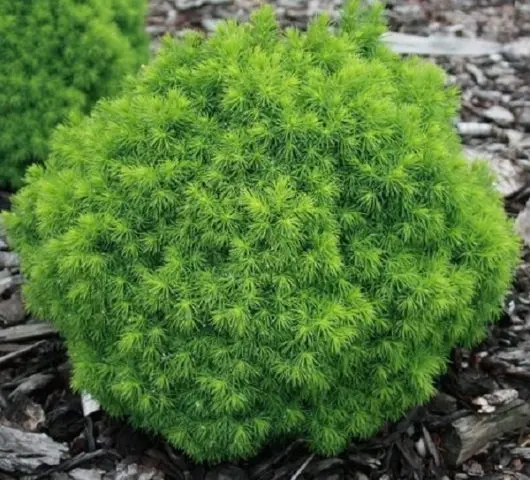
Description spruce Alberta Globe
All dwarf forms of coniferous plants appeared as a result of mutation. Previously, gardeners and breeders carefully examined species trees and existing varieties, hoping to find the source material for creating a new cultivar. Since the middle of the last century, the mechanism of mutation has been sorted out, and it is caused artificially. True, people have not yet succeeded in surpassing nature.
The variety of Canadian Spruce, Gray or White (Picea glauca) Alberta Globe (Alberta Globe) was obtained as a result of a natural mutation, like the original form – Konika. With a species plant, they have in common – the features of care and requirements for growing conditions, the main difference is in size. If a wild-growing Canadian spruce is stretched to a height of up to 40 m with a trunk diameter of 0,6-1,2 m, then the Alberta Globe variety is a real baby.
By the age of 30, the tree reaches 0,7-1 m with a width of 1 m. Canadian spruce Alberta Globe grows very slowly. In the first years, it increases by 2-4 cm in height and width. Approximately for the 6-7th season, a jump may occur when the growth is about 10 cm. It is possible that this will continue until the age of 12-15.
By the age of 10, the crown of Canadian spruce Alberta Globe has an almost perfect rounded shape and a diameter of about 40 cm. Then the variety grows very slowly, adding 1-2 cm each season, but without shearing, the tree often becomes wide-conical.
The crown of Alberta Globe is very dense, because with a decrease in size, compared to the species spruce of the Canadian spruce, the branches on the plant did not become smaller, just the internodes became short. Behind the abundance of needles, thin shoots are difficult to see, but their color is light brown.
The needles are light when bud break, by the end of the season it becomes bright green. It is much softer to the touch than Canadian Konik spruce, and thinner, 6 to 9 mm long. If you rub the needles of Alberta Globe in your hands, you can feel the aroma, similar to blackcurrant. Some consider the smell not too pleasant, but this is a matter of taste.
Buds rarely appear on this dwarf Canadian spruce variety. They are located at the ends of the shoots, have the shape of a cylinder, are painted in a light brown color and are much smaller than in the original species.
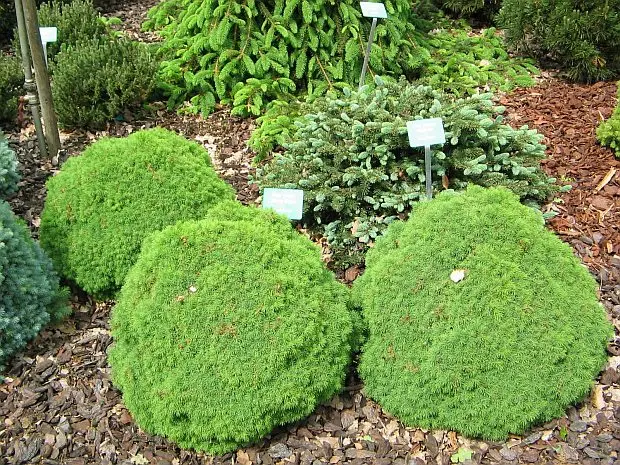
Use in landscape design
Now domestic gardeners have finally come to understand that coniferous crops do not carry negative energy to the site, but are able to improve the air and saturate it with phytoncides. In addition, in a cold and cool climate, where deciduous trees stand bare for almost half a year, and flowers are even less pleasing, only evergreen species can enliven the landscape.
Bonsai trees such as the Alberta Globe Canadian spruce are especially popular. For a small garden, they are simply irreplaceable, and in a large one they are used as the middle and lower tiers of landscape groups.
Due to its slow growth, small size and beautiful shape, the Canadian Alberta Globe spruce looks great in rockeries, rock gardens, in any flowerbed or ridge containing not too moisture-loving plants. The tree would be appropriate in an English or Oriental garden. But especially beautiful, as can be seen in the photo, the Alberta Globe spruce looks on a plot designed in a regular style.
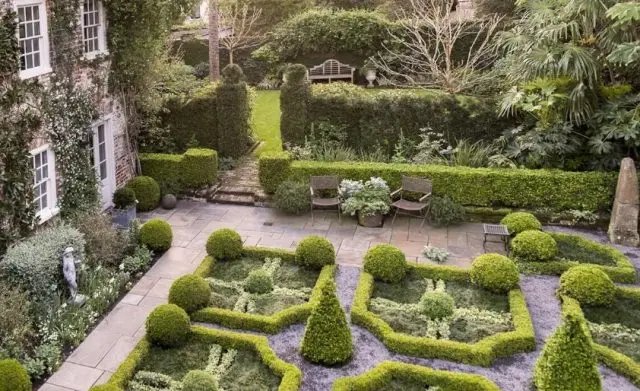
Those who do not like or cannot grow thuja due to the climate successfully replace globular dwarf varieties with Canadian Alberta Globe spruce.
The tree can grow in the shade. Unlike the Canadian Konik spruce, the needles of Albert Globe are green, not gray or bluish, and they do not fade in the absence of sunlight. And since the choice of crops that not only can be grown in the shade, but also do not lose their decorative effect there, the variety becomes even more in demand.
Alberta Globe pairs well with other ornamental plants, including flowers, as long as they don’t cut off the Canadian Spruce’s fresh air. And they do not put their branches, flowers or large leaves on the tree.
Planting and caring for blue spruce Alberta Globe
In the description of the gray-gray ate, Alberta Globe often writes that the plant almost does not need to be looked after. This is not entirely true. To keep the tree alive, it really only needs to be watered in the heat. But it will be impossible to look at him without tears. Dry brown needles on half of the spruce, bare branches, a cloud of dust flying out of the middle of the plant with every touch of the crown. And this is if the caterpillars do not devour the tree earlier.
In order for the Canadian Alberta Globe spruce to be healthy and serve as a decoration for the site, you will have to tinker, but the result is worth it.
Seedling and planting preparation
Canadian spruce grows best in a cool, shady spot, although it tolerates the sun quite well. She does not like strong winds, close standing groundwater, dense, dry or saline soils. Alberta Globe tolerates a slight temporary waterlogging of the soil, but will die when the root collar is jammed.
Best of all, Canadian spruce grows on loose, moderately fertile, permeable to water and air, acidic or slightly acidic sandy loam or loam. It is good if the Alberta Globe on the south side is at least slightly shaded by a larger plant, especially in late winter or early spring. Otherwise, the spruce will need to be covered from the sun with white lutrasteel or agrofibre.
A landing pit is dug with a diameter of 60 cm, a depth of at least 70 cm. Be sure to make a drainage layer of at least 20 cm from broken red brick or expanded clay. It is better to prepare a fertile mixture from soddy soil, sand, clay and acidic (red) peat. For Canadian spruce, the addition of leaf humus is allowed. Starting fertilizer is added to each planting hole – 100-150 g of nitroamofoska.
It is better to buy Alberta Globe seedlings in a nursery, 4-5 years old, when side branches began to form. Canadian spruce should be dug out with an earthen clod and sheathed with burlap, or the root should be lowered into a clay mash and wrapped tightly with a film.
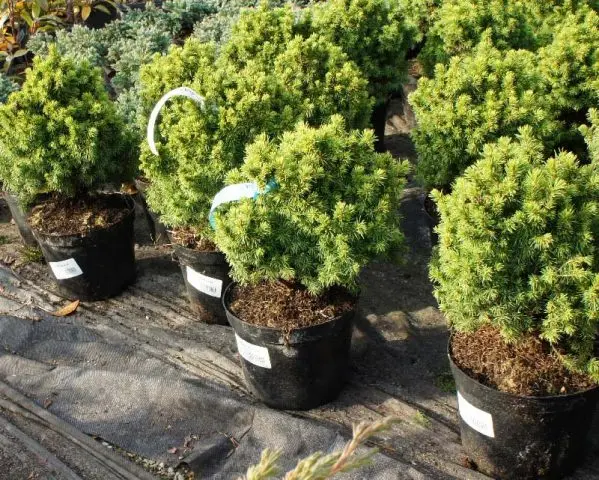
In retail chains, container plants should be chosen. Alberta Globe has soft needles with green rather than bluish coloration, this will help determine varietal compliance.
Pre-planting preparation consists in watering the container spruce, and preventing the root from drying out in the spruce grown in the ground.
Rules of landing
After the planting hole is dug, it is covered with 2/3 of the fertile mixture, filled with water and allowed to settle. When at least 2 weeks have passed, you can start planting Alberta Globe Canadian spruce:
- So much earth is taken out of the pit so that the root collar of the seedling installed in the center is on the same level with its edge.
- Spruce root falls asleep, constantly compacting the soil. If Alberta Globe was dug up with a clod of earth and sewn into burlap, the protective material is not removed.
- After planting is completed, the soil is carefully pressed with a foot, checked, if necessary, correct the position of the spruce root neck.
- An earthen roller is formed around the near-trunk circle and the tree is watered abundantly, spending at least a bucket of water per tree.
- When the liquid is absorbed, the soil is mulched with acidic peat with a layer of 5 cm or more.
Watering and top dressing
The first two weeks after planting, Canadian spruce is watered frequently to keep the soil from drying out. In the future, the soil is moistened less often. However, do not forget that most of the spruce roots are close to the soil surface, and the culture itself is quite moisture-loving. In hot summers, watering every week may be necessary.
Alberta Globe Canadian Spruce needs high humidity. It would be ideal to plant it next to the fountain, but not all sites have it, as well as a fogging installation. Spruce Alberta Globe should be watered with a hose every time, even if the soil is moistened under other plants.
This should be done early in the morning or at 17-18 hours, so that the crown has time to dry before the sun’s rays can burn the delicate needles, or before dark. In the evening, the needles dry more slowly, and fungal diseases can develop on long-remaining wet spruce.
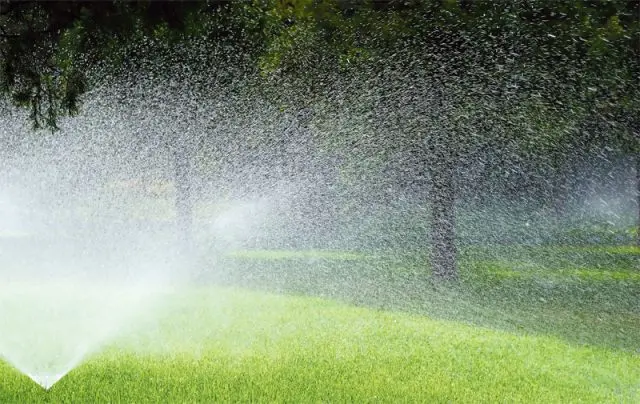
A young plant should be fed regularly. It is better to use special fertilizers designed for coniferous crops. They are released for each season separately, keeping the balance of nutrients needed by evergreens in different periods of development. It is necessary to apply such fertilizers, strictly adhering to the instructions. If the packaging indicates the dosage per 1 sq. m, it should be equated to 1 m of spruce height.
Trace elements necessary for the life of plants, including maintaining the decorativeness of needles, are better absorbed with foliar top dressing. They are called fast and are carried out no more than once every 2 weeks. It is better to use chelate complexes by adding magnesium sulfate to the balloon and alternately along the ampoule of epin or zircon.
Mulching and loosening
It is problematic to loosen the soil under the Alberta Globe spruce – its lower branches practically lie on the ground. But the first year or two after planting, this is necessary, especially after watering. Gardening stores sell miniature tools – these are not toys, but devices designed for such cases. With one hand, you should lift the branches of the spruce, and with the other, gently loosen the soil to a shallow depth so as not to disturb the sucking roots that come close to the surface.
Under an adult Alberta Globe spruce, it is better to mulch the ground with acidic peat or fungicide-treated bark of coniferous trees. This will not only conserve moisture and protect against weeds, but also keep the branches from lying on bare soil and protect them from infection.
Trimming
Canadian spruce Alberta Globe has a crown so beautiful that it does not need pruning. But sometimes (very rarely) an ordinary shoot appears on the tree. It should be removed immediately, otherwise it will not only spoil the appearance, but will quickly take a dominant position, turning the varietal plant into an ordinary Canadian spruce.
An old Alberta Globe tree can lose its shape and become a wide cone instead of a ball. That’s when the decorative effect is supported by a haircut, cutting off the shoots in early spring, before the buds open.
Crown cleaning
The crown of the Canadian spruce Alberta Globe is very dense and poorly ventilated. Water almost does not get there during processing, dousing the crown and during rain. A lot of dust collects inside the crown of the Alberta Globe spruce, dryness contributes to the spread of mites, which consider such conditions ideal. Therefore, during the processing or moistening of the tree, you should move the branches apart with your hands, be sure to moisten the bole and adjacent branches.
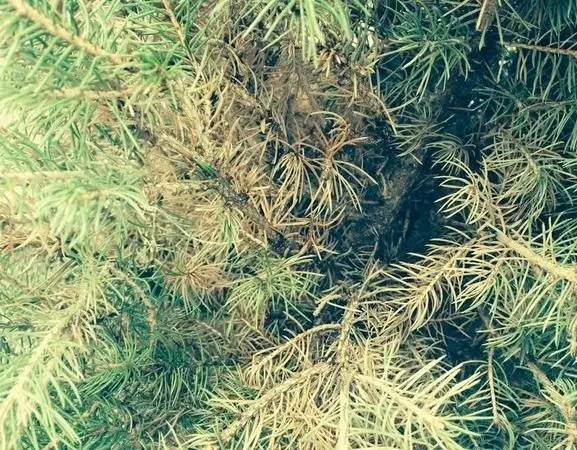
The sun’s rays cannot illuminate the inner part of the crown of the Alberta Globe spruce, the needles there quickly dry out, as well as part of the branches. It’s almost impossible to cut them off. Firstly, it is inconvenient – with one hand you need to push back the shoots covered with needles, and with the other work with pruners. Secondly, there are so many shrunken branches that it can take all day to remove them. But if someone has the time and desire, you can do sanitary pruning – this will only benefit the tree.
Busier gardeners should regularly clean the canopy of Alberta Globe Canada Spruce. To do this, wear sleeves, a respirator, goggles and gloves (preferably with rubberized pimples on the palms and fingers). Why such precautions, anyone who has ever cleaned the Canadian fir trees of Konik or Alberta Globe will understand – dust flies into the eyes, clogs the nasopharynx, needles scratch and irritate the skin.
At the tree, the branches are carefully pushed apart, and all the dry needles are cleaned off with their hands. All! Of course, it will take a lot of time, and it is difficult to call the procedure pleasant. But this must be done, and at least three times per season:
- first time immediately after winter, before bud break, before carrying out the first preventive treatment with copper-containing preparations;
- second time – 10-14 days after the spring treatment with fungicide;
- third time – in the fall, before spraying Canadian spruce with copper preparations.
And this is the minimum! Each time after cleaning, Alberta Globe spruce is treated with a fungicide that contains copper better, with special attention being paid to the inside of the crown – it should be blue from the drug.
And now a word of caution. If cleansing is ignored, Alberta Globe Canadian Spruce will become a breeding ground for mites that will spread to other crops. And it is difficult to remove these microscopic pests. Spruce will lose its decorative effect. People who are near the ephedra will not inhale phytoncides, but dust in half with ticks.
Preparation for winter
Canadian spruce Alberta Globe is quite frost-resistant, it winters well without shelter in zone 4, and according to gardeners, in 3a. Protection is needed only for young plants in the year of planting – they are covered with spruce branches or wrapped with white agrofiber, which is fixed with twine.
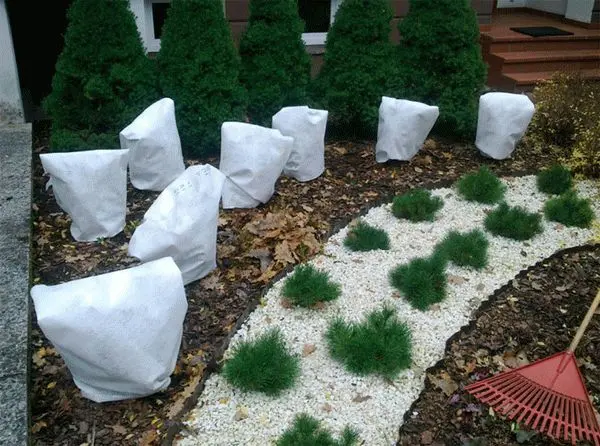
Further, the soil is mulched with a layer of acidic peat, in the spring it is not removed, but shallowly embedded in the soil. If during the growing season the soil was covered with bark, it is raked and stored in a dry room. In the spring, the mulch is returned to its place.
Among the measures that increase the frost resistance of Canadian spruce are autumn water charging, which is mandatory for all crops, and top dressing with a phosphorus-potassium complex (autumn fertilizer for conifers).
sunburn protection
Canadian spruce varieties Alberta Globe suffer from sunburn less than Konika. But all the same, it needs to be covered with white lutrastil or agrofibre, starting from February. It is even better to plant a spruce under the canopy of larger plants that provide light shade even in spring.
In summer, the tree also suffers from overheating, although less than in spring, when the needles actively evaporate moisture, and the roots in the frozen ground are not able to make up for its lack. The southern side of the spruce is especially affected. The needles turn yellow, turn brown, dry out and fall off. This does not give the tree a decorative effect. Of course, it is possible to cover the Alberta Globe spruce, which is constantly in the sun, with lutrastil until autumn, but it looks unattractive, and the tree grows on the site to decorate it.
Proper care, sufficient, but not excessive fertilizing and watering, crown irrigation can help. But the main thing is that once every 2 weeks the tree is treated with epin. This will help protect the spruce from burns, and if trouble has already happened, grow new needles faster.
Reproduction
Canadian spruce Alberta Globe is propagated by grafting or cuttings. A species tree will grow from the seeds. Grafting and cuttings of conifers is not a task for amateurs. Gardeners can try to root 10-12 cm long twigs from the lower part of the crown, cut with a piece of bark from an older shoot.
The cuttings are treated with a root formation stimulator, planted in perlite, sand, or a mixture of soddy soil and sand to a depth of 2-3 cm. The part of the shoot that will be in the substrate is freed from needles. Containers should have drainage holes for water outflow. They are placed in a cold greenhouse, located in a place protected from the sun, and evenly watered.
Some of the cuttings will take root, they are transplanted into a more nutritious mixture consisting of sand, peat and soddy soil. They are transplanted to a permanent place after 4-5 years, when a whorl of buds appears on the top of the Alberta Globe spruce, from which lateral branches will develop.
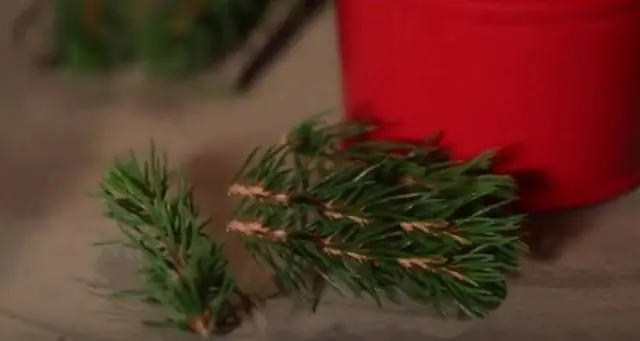
Diseases and pests
The biggest problem (albeit not the most noticeable) of Alberta Globe spruce is a spider mite that starts on conifers with a lack of moisture in the air. A dense crown does not let water through, and if the tree is not cleaned (and regularly) and water procedures are ignored, you can get a hotbed of pests and diseases on the site.
Other insects include:
- spruce sawfly;
- caterpillars of the Nun butterfly;
- gall aphids;
- hermes;
- spruce leaflet.
The most common Canadian spruce diseases:
- fusariosis;
- snow and regular shutte;
- rot;
- dry necrosis;
- wound cancer;
- rust;
- spruce spinner.
They fight pests with the help of insecticides, acaricides help better against ticks. Fungicides are used for diseases. Be sure to carry out preventive treatments of Canadian spruce with preparations containing copper in spring and autumn. Particular attention should be paid to the inner part of the crown.
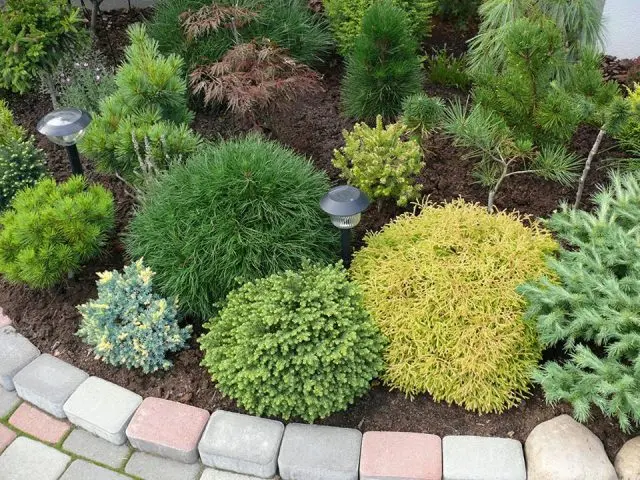
Conclusion
Canadian spruce Alberta Globe is a very beautiful miniature coniferous tree. Caring for him is not so easy, but all the efforts spent on the plant will pay off handsomely. To simplify your life and not waste time on treatment and putting the crown in order, you should simply follow all the rules of agricultural technology.









